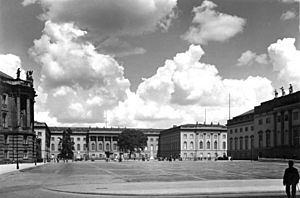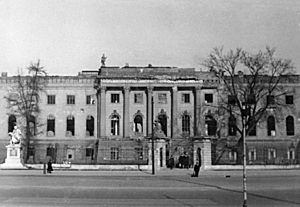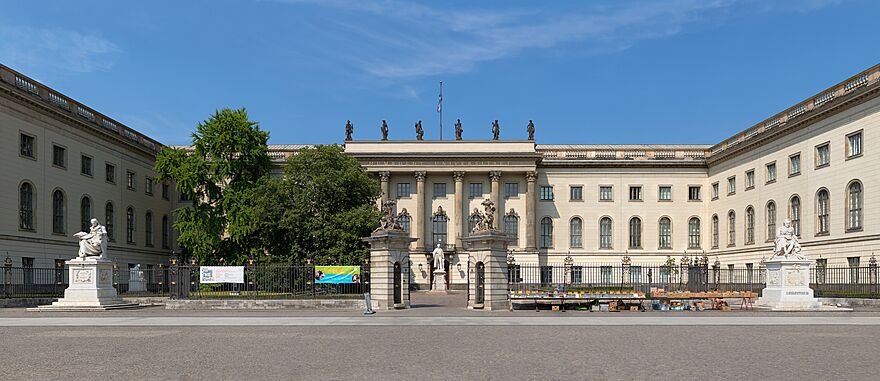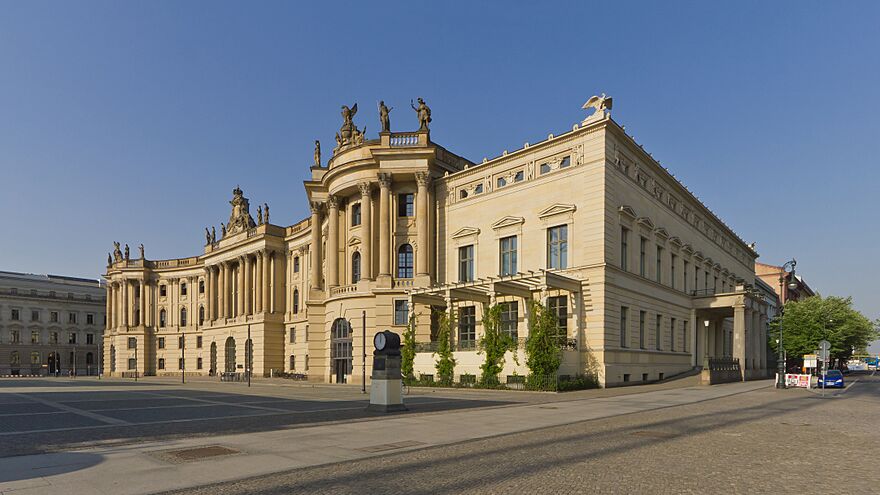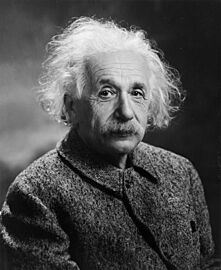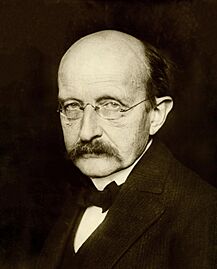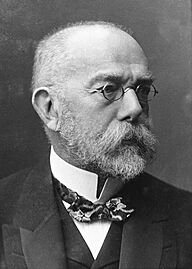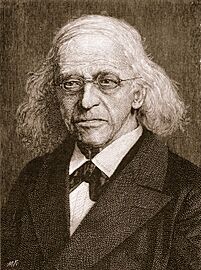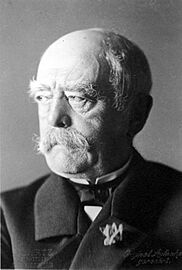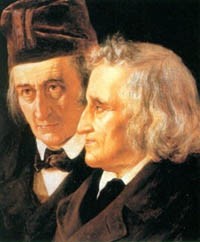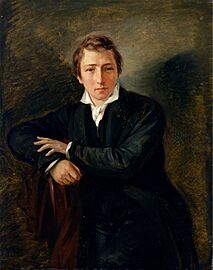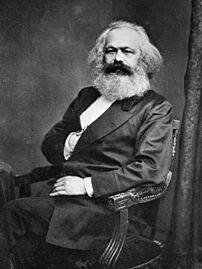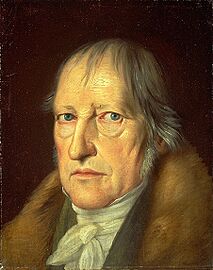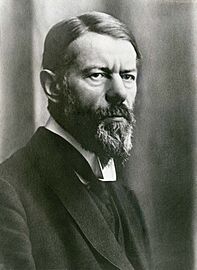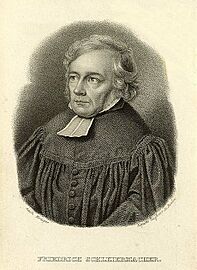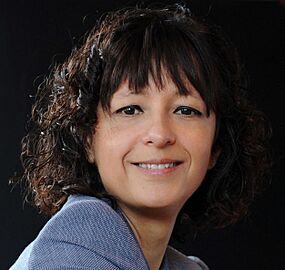Humboldt University of Berlin facts for kids
|
Humboldt-Universität zu Berlin
|
|
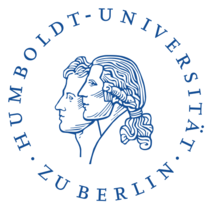
|
|
|
Former name
|
Friedrich-Wilhelms-Universität zu Berlin |
|---|---|
| Motto |
Universitas litterarum (Latin)
|
|
Motto in English
|
The Entity of Sciences |
| Type | Public |
| Established | 15 October 1810 |
| Budget | €536.0 million (2022) |
| President | Julia von Blumenthal |
|
Academic staff
|
2,403 |
|
Administrative staff
|
1,516 |
| Students | 32,553 |
| Undergraduates | 18,712 |
| Postgraduates | 10,881 |
| 2,951 | |
| Location |
,
Germany
52°31′05″N 13°23′36″E / 52.51806°N 13.39333°E |
| Campus | Urban and suburban |
| Nobel Laureates | 57 (as of 2020) |
| Colors | Blue and White |
| Affiliations |
|
 |
|
The Humboldt University of Berlin (called Humboldt-Universität zu Berlin in German) is a famous public research university in Berlin, Germany. It is one of the oldest and most respected universities in the country.
The university was started in 1809 by the King of Prussia, Frederick William III. The idea for the university came from important thinkers like Wilhelm von Humboldt, who wanted to create a new kind of university. It officially opened in 1810 as the University of Berlin. Later, it was named the Friedrich Wilhelm University and kept that name until 1945.
After World War II, Berlin was divided into East and West. The university was in East Berlin. A new university, the Free University of Berlin, was opened in West Berlin. In 1949, the original university was renamed Humboldt University to honor its founder, Wilhelm von Humboldt, and his famous brother, the scientist Alexander von Humboldt.
Today, the university has nine different schools, called faculties, including a medical school that it shares with the Free University of Berlin. About 35,000 students study there. The university is famous for creating the Humboldtian model of higher education, a new way of teaching and research that many other universities around the world have copied.
Many famous people have studied or taught at Humboldt University. This includes 57 Nobel Prize winners, such as the famous physicist Albert Einstein. Other important figures include Karl Marx, Otto von Bismarck, the Brothers Grimm, and Max Planck.
Contents
History of the University
The Main Building
The main building of Humboldt University is a beautiful palace called the Prinz-Heinrich-Palais (Prince Henry's Palace). It is located on a famous street called Unter den Linden in the center of Berlin. The palace was built between 1748 and 1753 for Prince Henry of Prussia, who was the brother of King Frederick the Great.
In 1809, this royal palace was turned into a university building. It was damaged during World War II but was rebuilt between 1949 and 1962.
How the University Began

King Friedrich Wilhelm III of Prussia founded the university on August 16, 1809. The main person behind the idea was Wilhelm von Humboldt, a smart philosopher and language expert. He wanted a university where teaching and research were combined.
The first students started on October 10, 1810. There were 256 students and 52 teachers. The university had schools for law, medicine, religion (theology), and philosophy. From 1828 to 1945, it was known as the Royal Friedrich Wilhelm University.
The university quickly became a place for serious learning. A student named Ludwig Feuerbach wrote in 1826:
"...in no other university can you find such a passion for work... such an inclination for the sciences, such calm and such silence. Compared to this temple of work, the other universities appear like public houses."
Many of Germany's greatest thinkers studied or taught here. This includes philosophers like G.W.F. Hegel and Arthur Schopenhauer, and scientists like Albert Einstein and Max Planck. Other famous students were Karl Marx, the poet Heinrich Heine, and the German leader Otto von Bismarck.
Growth and New Subjects

The university didn't just teach old subjects. It also added many new areas of science. Wilhelm's brother, Alexander von Humboldt, was a famous scientist who helped the university grow. New research buildings were built, which helped the university become a world leader in the natural sciences.
Famous scientists like the physicist Hermann von Helmholtz and the doctor Robert Koch, who discovered the causes of major diseases, helped make the university famous.
Over time, the university grew by joining with other colleges in Berlin. For example, the Charité, which started as a hospital in 1710, became the university's medical school in 1829. The university also started a natural history collection in 1810, which grew so large that it became its own museum, the Museum für Naturkunde, in 1889.
The Nazi Era
After 1933, when the Nazi party took control of Germany, the university changed. About 250 Jewish professors and staff were fired in 1933 and 1934. Students and teachers who disagreed with the Nazis were also forced to leave.
On May 10, 1933, a terrible event happened. About 20,000 books from the university's library were burned in a public square near the university. These books were written by Jewish authors or people who opposed the Nazis. Today, a memorial called The Empty Library is in the square. It is an underground room with empty bookshelves, visible through a glass plate in the ground. A plaque has a quote from the writer Heinrich Heine:
"Das war ein Vorspiel nur,
dort wo man Bücher verbrennt,
verbrennt man am Ende auch Menschen."
("This was but a prelude;
where they burn books,
they ultimately burn people").
The Cold War Period
After World War II, Berlin was divided. Humboldt University was in East Berlin, which was controlled by the Soviet Union. The university reopened in 1946, but there was little freedom. The new government controlled what was taught, and students who protested were arrested.
Because of this lack of freedom, a new university was founded in West Berlin in 1948. It was called the Free University of Berlin to show it was part of the "free world," unlike the university in the East.
In 1949, the university in East Berlin was renamed Humboldt University of Berlin. This was to honor the Humboldt brothers and move away from the old name connected to the Prussian kings.
The University Today
After Germany was reunited in 1990, the university was completely updated. Today, Humboldt University is a modern public university. In 2014, it had almost 37,000 students, including over 4,600 from other countries.
The university has three main locations, called campuses:
- Campus Mitte: This is in the center of Berlin. The main building is here, along with the schools for humanities, law, business, and economics.
- Campus Nord: This is near the main train station. It is home to the life sciences departments, including the Charité medical school.
- Campus Adlershof: This is in the southeast of Berlin. The natural sciences, computer science, and mathematics are taught here.
University Library
The university's library was founded in 1831. In 2009, a new main library building opened called the Jacob and Wilhelm Grimm Centre (Grimm-Zentrum). It is named after the famous Brothers Grimm, who were once professors at the university.
The library is one of the largest in Germany. It holds about 6.5 million books and 9,000 magazines and journals. The books on natural sciences are located in a separate library at the Adlershof campus.
Famous People
Many famous people have studied or taught at Humboldt University. They are known for their work in science, philosophy, politics, and the arts.
-
Albert Einstein, a physicist who developed the theory of relativity and won a Nobel Prize.
-
Max Planck, a physicist who created quantum theory and won a Nobel Prize.
-
Robert Koch, a doctor who discovered the germs that cause major diseases.
-
Rudolf Virchow, a doctor known as the "father of modern pathology."
-
Theodor Mommsen, a famous historian who won the Nobel Prize in Literature.
-
Otto von Bismarck, the first Chancellor of Germany.
-
Jakob and Wilhelm Grimm, who collected famous German fairy tales.
-
Heinrich Heine, a famous German poet.
-
Karl Marx, a philosopher and political thinker.
-
Friedrich Engels, a philosopher who worked with Karl Marx.
-
Georg Wilhelm Friedrich Hegel, an important philosopher.
-
W.E.B. Du Bois, an American civil rights activist and writer.
-
Max Weber, a sociologist who studied how societies work.
-
Friedrich Schleiermacher, a theologian and philosopher who helped found the university.
-
Emmanuelle Charpentier, a scientist who won the Nobel Prize in Chemistry.
See also
 In Spanish: Universidad Humboldt de Berlín para niños
In Spanish: Universidad Humboldt de Berlín para niños
- History of European universities
- List of split up universities


